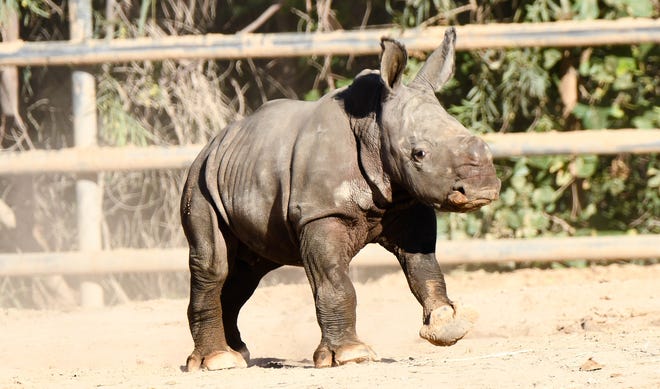
A baby white rhino with mischievous ears and a lively personality is the new pride of Wildlife World Zoo. Her recent birth has been awaited for decades in Arizona, and is the most significant to ever happen at the zoo.
The one-month-old calf, named Siki, had visitors and staff members at the zoo captivated with her energetic and curious gestures, said Kristy Hayden, president at Wildlife World Zoo, Aquarium & Safari Park.
“She runs around and falls, and mom is very attentive and always close behind her, and then she gets tired and takes very long naps,” Hayden said. “It’s so cute.”
How Siki is helping conserve her species
Siki’s birth had been in the making for nearly a decade as part of a rhino conservation breeding plan led by the zoo, Hayden said. Rhinos are a species at risk of extinction with population numbers dramatically decreasing due to illegal hunting activities.
According to the zoo, about 500,000 rhinos roamed the wild at the start of the 20th century. Only about 27,000 rhinos continue to live today in Africa. Those numbers continue to drop at an alarming rate because more than three rhinos are poached each day in South Africa, Hayden said.

“If something isn’t done to stop the amount of poaching right now, they actually could be extinct from the wild within our lifetime,” Hayden said.
So, when the zoo found out Siki was on her way, they knew she was going to be a big deal.
According to Hayden, rhino specialists at the zoo monitored Siki’s mom’s pregnancy very closely day by day through husbandry behaviors. Keepers and veterinarians worked with her to perform close visual inspections and regular ultrasounds, did bloodwork, placed her in a different area from the rest of the herd through the pregnancy and first months of the baby and attended to all her health care needs during the pregnancy.
Although these were not easy tasks, Hayden said Siki’s mom, Zuri, participated in everything through positive reinforcement. Siki, however, was the one to give staff members a hard time.
“She was tough to monitor through ultrasound because her ears kept getting in the way,” said Wildlife World’s rhino specialist Emily Kading. “After she was born, her ears were one of the first things to move!”
Hence, the baby rhino was named Siki, short for Masikio, which means ears in Swahili.
‘She’s so full of energy’
“She’s the most significant birth we’ve ever had here at Wildlife World,” Hayden said. “She’s the product of a lot of really hard work, and she’s going to be a key part of rhino conservation for decades to come.”
The zoo’s conservation project brought in three female orphaned rhinos from South Africa. Zuri, Siki’s mom, was one of them.
Maoto, Siki’s father, was acquired from the San Diego Zoo Safari Park and he was also once imported from South Africa. All rhinos, according to Hayden, are “genetically very valuable,” and the females have three completely new bloodlines for breeding to ensure genetic diversity to sustain the species.
Little Masiki was the product of the efforts put into the project and the funds donated by local, national and international organizations dedicated to the survival of endangered animals.
Siki has been growing quickly and is very healthy, Hayden said. She was under 100 pounds when she was born and has been gaining about 10 pounds a day since.
“She’s so pretty, she’s getting big and she’s so full of energy,” Hayden said. Siki and her mom were expected to be reintroduced to the herd starting next week, but it was expected to be a gradual process.
How to see the new baby rhino
Valley residents can meet little Siki at the zoo, located at 16501 West Northern Avenue in Litchfield Park. The zoo is open every day, including all holidays, and zoo exhibits are open from 9:00 a.m. to 6:00 p.m., but Hayden recommends visiting Siki in the morning hours.
“First thing in the morning, when she’s out the yard, she is just so full of life,” Hayden said. “So, I definitely recommend coming in the first part of the day.”
